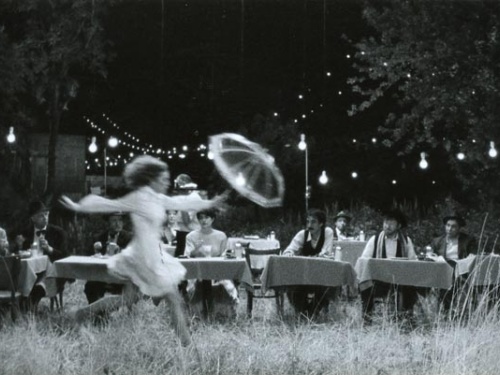Planning a Screening: News From Home
On Thursday 23 January A Nos Amours screen Chantal Akerman’s 1977 film News From Home. Adam Roberts explains the motivation behind the unique double screening of the English language and French language versions.
Akerman made two versions - one in English and one in French - which should perhaps not surprise us since she, more than many film artists, has one foot in the New York of Michael Snow, Jonas Mekas and Andy Warhol and the other in the Europe of André Delvaux, Jean-Luc Godard and Rainer Werner Fassbinder (all mentioned and discussed by Akerman at various times).
These two versions of this film offer identical images and sound atmospherics, but differ in that Akerman’s voice reads letters from her Mother in one case in French and the other in English. Delivery and tone differ somewhat – in French, Akerman is speaking in her native language, the language she shares with her Mother, and in the English, an acquired language after all, and one that her Mother may or may not know.
These letters were written and first read when Akerman was in New York in 1972, a stay that produced Hotel Monterey and La Chambre. Of course the English language version is a translation – no credit is given for translation, but this was done presumably by Akerman herself. This is a further point of difference then: the English language version offers words not just selected and edited by a daughter, but have passed into and through, in the act of translation, a daughter.
The French version comes across as perhaps more casually read, more easily read, less formal. The English version, given the relative unfamiliarity of the language, seems perhaps more affirmative, more declamatory. Ackerman has described her voice-over as intended as a kind of psalmody, a murmured incantation. To hear both versions will be a chance to compare and contrast.
When planning this screening, we found that we could book a 16mm print with the French soundtrack, without subtitles, which is how the film has necessarily most often been seen. Luckily, The Royal Belgian Film Archive have recently begun restoration of many of Akerman’s films from the 1970s, including News From Home, and could offer us the English language version.
We wondered what to do. If we wish to present the film (as is our habit) in original format (in this case 16mm film) should we then attempt to project subtitles, cued live, with dirt and scratches and joins? Or should we screen the restored film, as so many back-catalogue films now are, cleaned of ‘defects’, and with the rare English language soundtrack?
Of course watching subtitled films is a deeply familiar experience for most of us. We watch films hardly noticing our eyes flicking up and down, reading the lines, then seeing speakers move their lips to make utterances in a language we speak badly or not at all. But then by some mysterious alchemy we start to hear them speak in English (I’m assuming you, like me, to be a native English speaker).
The rhythm of the titles coming and going soon fades from awareness. I suggest that we hardly notice the dynamic edge that this procedure adds to our experience of a film.
I am not suggesting that subtitling is ever a mistake. Dubbing in some parts of the world is the norm – where a few actors re-record the lines and that is used to make a new soundtrack in the local language. In Italy, the actors whose voices are familiar because they have dubbed so many films are themselves celebrities. Dubbing is of course a kind of remaking of a film, surely always more radical than subtitling. And bedevilling both approaches is the problem of translation – always faulty and often just plain wrong.
To return to the screening of News From Home, and its possible subtitling. The coming and going of subtitles is not nothing – it is a very profound intrusion into the intended rhythms of a film work. In the case of a work of such gentle and surreptitious rhythmical structuring as is News From Home, subtitles would perhaps be an utterly destructive intrusion. I watched the film again and found myself reading and not looking, and only then when the flow of subtitles halts for a while, having the chance to look and stare at the images. When the flow of subtitles resumed my attention scuttled back to them, leaving me anxious in case I had missed a few. Not so good.
For these reasons, Joanna and I wondered about a double bill screening, first of the English language version of News From Home, so that we might first take in what it is that is being said, and then with the restored French language version without subtitles, be in a position to take in the film itself as the sole source of rhythm.
This will divide the audience of course – some may speak French, while others would not. We wonder how this will be, and invite feedback to info@anosamours.co.uk. We will, by the way, make available paper copies of the text in English to anyone who wants it.
Other concerns to consider: the restored copy lacks ‘weave’, that gentle movement of the frame due to camera and projector imperfections, the restored copy has clean sound, without the analogue hiss and limited frequency range of a 16mm film optical sound track. The film copy has colour faded (it has ‘magenta lift’), it has joins and dirt and scratches. The restored copy looks like it was shot yesterday. The film copy looks like an archaeological relic - it looks its age.
We are also interested in the experience of watching this film twice in quick succession (forgetting the language difference for now). This is a rare way of seeing films nowadays, though once upon a time it was possible to sit through successive programmes in cinemas, whereas nowadays the auditorium is cleared between screenings.
In any case, it was certainly rare for us to watch a film again straight away, until we began running films and prints to check their condition shortly before screening them with an audience. These repeat viewings have been a revelation. The films have seemed to us to be positively enhanced by this repeat encounter. This goes for the films we knew well, films we had seen long ago, or films we had never before seen.
Chantal Akerman’s films in particular have certainly benefited from the chance to see them repeatedly. Repeat viewings show her films to be endlessly surprising, and despite use of repetition and often minimal staging, full of rich and rewarding detail that we might otherwise have missed. This is true even (perhaps especially so) of Jeanne Dielman, which runs of course for more than three hours. One viewing might reveal details of movement and choreography, another of structuring and another sound design. Each viewing reveals something new.
For us, repeat viewings have made the films more visible, more gripping, more admirable. We wonder what you will think.
Adam Roberts
www.anosamours.co.uk
A Nos Amours: Chantal Akerman 4: News From Home, Thursday 23 January, 7pm
This article is posted in: Articles, Film
Tagged with: A Nos Amours, Chantal Ackerman, News From Home, French, 16mm





